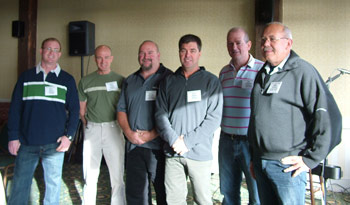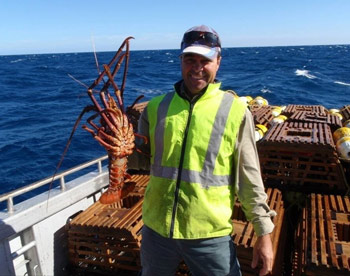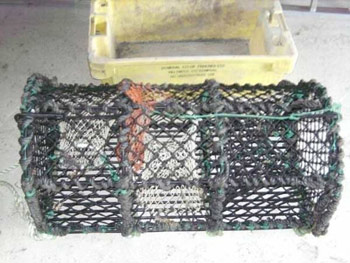Fishermen From Around the World Visit Maine

Lobstermen visiting Maine at the Fishermen's Forum in March. Left to right. Scott Bruce, PEI, Canada; Robert Harris, Nova scotia, Canada; Neville Perryman, Tasmania, Australia; Chris Beissel, West Australia; Ger O Mahony, Ireland; Larnce Wichman, New Zealand. The lobstermen visited 8 Maine towns to discuss lobster fishing here and in their home ports. Fishermen's Voice Photo
Lobster fishermen in Maine had a chance to learn about lobster industries around the world, when fishermen from Australia, Tasmania, New Zealand, Ireland, Nova Scotia, and Prince Edward Island visited the state for two weeks.
Organized by the Maine Lobstermen’s Association, the foreign fishermen hit the ground running when they spent three days at the Maine Fishermen’s Forum and moved on to many meetings along the coast – visiting wharves and local businesses, attending community dinners, and giving talks in down east, midcoast and southern Maine locations. Maine families provided home-stays for the entourage.
In Ellsworth, the fishermen expressed their delight with the concept of sharing global perspectives on the fishery.
“It’s been a fantastic experience coming to your country and seeing your industry here,” said Larnce Wichman, from New Zealand, who has been involved in the rock lobster industry for 30 years.
Maine fishermen agreed.
“This is so full of information, it’s incredible!” said one man. “I’ve got questions for each one of you!”
The visiting fishermen were all from English-speaking countries, and all were leaders in their industries, mainly as heads of their various industry associations.
The goal for Maine, said MLA executive director Patrice McCarron, was to learn about management and marketing techniques in other countries.
“It’s really meant to get information and get people thinking,” McCarron said.
Fishermen from all sides of the world were interested to learn how much bigger the Maine lobster fishery is than anywhere else and how much less Maine fishermen earn per pound fr their product, and about the differences in fishing practices around the globe.

Chris Beissel, Carabooda, Western Australia with the rock lobster he fishes off the west coast of Australia. The heavy wooden traps in the background may be hauled twice a day. MLA Photo
Maine last year landed 76 million pounds, and the state’s landings peaked at 88 million pounds in 2002. Nova Scotia is a near-competitor in the landings game, having taken 71 million pounds last year, but the province averages 38 million pounds.
y comparison, the Pacific nations average from 3 million pounds in Tasmania to 17 million pounds in Australia. Ireland took only 1 million pounds in 2008.
On price, Maine and Nova Scotia are again comparable, with Maine averaging $2.90 per pound for soft-shell lobster and $5 per pound for hard, and Nova Scotia last year averaging $4.83 per pound.
Ireland ups the ante a bit, with fishermen getting $8.99 per pound.
For the Pacific nations, it’s again quite a different story. New Zealand averages $28 per pound, Tasmania $19.85 per pound, and western Australia $11.50 per pound.
Maine, New Zealand, and Ireland can fish year-round. Prince Edward Island has only two months to fish, May and June. Australia, Tasmania and Nova Scotia are restricted from fishing in the summer.
Maine has by far the largest number of license-holders, 6,260. This compares with Ireland’s 1,588, Prince Edward Island’s 1,300, Nova Scotia’s 987, Western Australia’s 800, Tasmania’s 319, and New Zealand’s 257.

Irish Lobster trap. Ireland has no trap limit. “But you know, we work to live, not live to work.” -– O’Mahoney MLA Photo
Ireland
In Ireland, fishing is regarded as being fairly low down on the pecking order as far as status is concerned, said Gerard O’Mahoney, who lives in Ardfert in County Kerry, fishes out of Fenit and has been lobstering for more than 20 years. He also goes crab and shrimp potting and oyster dredging.
“We have a very small fishery compared to yourselves,” said O’Mahoney.
Ireland has no trap limit, and a variety of fishing practices can be found, from single-handers fishing 1,200 traps and others fishing 200. The average number is 400.
“A fellow asked me, ‘You have no trap limit. Why don’t you go whole hog?’” O’Mahoney said of a chat he had with one Mainer. “But you know, we work to live, not live to work.”
Ninety percent of the product goes to France and too often, O’Mahoney said, France markets the product as French.
“We need to learn more about marketing,” he said, echoing a strengthening sentiment among Maine lobstermen.
Ireland has a V-notch program, like Maine, and credits that circumstance to Maine’s influence.
Unlike Maine fishermen, Irish fishermen are paid 55 percent of the value of V-notched lobster thrown back.
Australia
Chris Beissel, from Carabooda, Western Australia, is a second-generation fisherman who has fished out of Perth for 25 years. Fishermen in Australia, Tasmania, and New Zealand harvest rock lobster.
Over the past few years, he said, the fishery has seen a substantial decline in juveniles. So the fishery took a big cut in effort in order to reduce landings.
“We’re not getting the landings we have done in the past,” Beissel said. “In three or four years’ time, we’re looking at some pretty poor seasons. So we’ve taken the idea that we’ll reduce our catches and try and push stocks through those four years, let them grow a little more, look out for our breeding stock and hopefully ride out this poor time. We’re all crossing our fingers that we’ll get a good settlement in the coming years.”
A limited entry system has reduced the number of boats in recent years from about 800 to only 292 boats now.
“The guys have sold out, they’ve sold their boats, they’ve sold or leased their licenses to the ones that want to stay,” said Beissel. “The message was loud and clear that if we’d carried on the way we were, a lot of guys would have gone broke anyway. It had to happen. We were way overcapitalized and the vessels averaged about a thousand horsepower. It was a race to fish when the season started. Everyone was out there flat-out catching as much as they possibly could, and it did nothing for our markets.”
Most of the Australian product goes to China, and some to Europe and France, he said.
“The Chinese would sit over there waiting for our freezers to get full, and then they’d come in and start buying and they just crucified us every year,” he said. “So we got smarter and started smoothing out our catch, catching at the right time and delivering high-quality product.”
Fishermen are allowed to trade, sell, and lease their permits, which helps ensure that future generations can get into the fishery, he aid.
“The older generation can step off the boats and the sons come on and pay a fee or a percentage of the catch to the fathers, and the young fellows can work a bit a harder and buy their license as they go,” said Beissel. “So it’s a good system that we have.”

“You’ve to know what’s coming out of the water. You’ve really got to get a handle on that.” Neville Perryman – Tasmania.” A second generation fisherman Neville fishes in 15 foot seas on a 65’ boat in remote areas off Tasmania. Laurie Schreiber Photo
Tasmania
Neville Perryman is from Margate, Tasmania, an island about the size of Maine that is an Australian state. Perryman has been lobstering for 28 years and also does some fishing for shark and skate. Fishermen can have 50 traps, and they pull once or twice a day, or more, if they’re really keen.
“It’s not a bad way to make a living in Tasmania nowadays,” Perryman said. “A few years ago the picture wasn’t so good. In the mid-80s the stock assessment was going down. This was identified by logbooks, which fishermen have filled out mandatory in Tasmania since just after the First World War.”
The fishery operates under a quota due to a declining stock assessment. This year, the quota is 3.3 million pounds, and that number is expected to decrease if the stock doesn’t improve, he said. China is the biggest market.
“We were lucky,” he said. “Every time we’ve taken a cut, the price has gone up” – currently to $19.85 per pound.
At the moment, he said, Tasmania has only 224 active fishermen. The industry has a good relationship with fishery scientists and observers.
“We trust them implicitly,” Perryman said. “This trust has been built up; we work well with our government.”
As a small fishery, compared with Maine, the focus is on quality product, he said. Lobsters are sorted on the boat, and anything that’s damaged goes back over to breed “It’s worth more that way than coming in and taking a lesser price,” he said.
New Zealand
Larnce Wichman of New Zealand has been involved in the rock lobster industry for 30 years. New Zealand’s lobster fishery operates on a system of quotas that can be leased to other fishermen. Currently the value of that lease is a pricey $35,000 a ton. With the cost of a larger vessel of 65 feet averaging $290,000 and gear cost on average $175 per pot, getting into the fishery is expensive, he said. However, anyone with the money and a skipper’s license can get in, he said; there are no particular qualifications, nor limited entry.
“Fishermen can be anyone off the street,” Wichman said.
Although it’s not hard to get into the fishery, it can be hard actually to get into the water. The coasts of New Zealand’s two islands are very exposed to the extreme weather conditions of the Tasman Sea; it’s not uncommon to see swells of 20 to 30 feet roll up on the shore.
“We do not have the opportunities to have port facilities,” he said, “so there’s a lot of trailer-launching. We do have strict environmental policies by the local regional councils; we can’t just go and stick a pier out there.
For the year-round fishery, New Zealand saw a haul last year of 6.6 million pounds, relatively small by Maine standards. The New Zealand fishermen makes a point of taking only quality product in order to maximize their market.
“You cannot export lobsters and have mortalities. You’re crucified, literally,” he said. “Very high prices we receive, but any mortalities over 5 percent that hits the international market will lose 50 percent of the value. And that 50 percent of the value is more than what we’re paying for this product with respect to the cost of getting the product to the market.”
The price for high-grade lobster this year is $28 per pound.
“The fisher has the opportunity to look at the price per week,” Wichman said. “Normally they would pick on two or three grades and go about high-grading, so he’ll only land on those grades that the price pertains to. Hence they have the opportunity to maximize their value.”
Most of the product is sent to Asia – primarily China, but also Malaysia, Korea, Taiwan, and Japan. New Zealand fishermen are market-saavy; they track their markets, said Wichman, making sure, for example, to have plenty of high-grade product to sell to China during that country’s high holiday seasons.
“Since 1986 we’ve kept records of the market,” he said. “There are certainly peaks and troughs in different markets.”
Six percent of the product remains in New Zealand, and about 2 percent – the lowest grade of product – goes to the U.S. “There’s huge incentive for the fishers to get their quality right so they will not have 2 percent as the reject,” he said. “The total effort is to try to drive to 100 percent live.”
Maine
One Maine fisherman said that, because most Maine lobsters are caught in the late summer/early fall months, the industry experiences tremendous pressure to haul and market the product, regardless of the price and without any particular attention to grades. Conversely, when lobsters are held in pounds in anticipation of a price rise, the product have lost a lot of conditioning by the time they get to market.
“We’re fishing our hardest and catching the most product when it’s lowest quality and we’re not concentrating on the high quality like you guys are,” he said.
Fishermen from the Pacific nations urged Maine fishermen to get a better handle on their markets and concentrate on high-quality product.
“You’ve to know what’s coming out of the water. You’ve really got to get a handle on that,” said Tasmania’s Neville Perryman. “Maine lobster is known worldwide; it’s a great brand. We wish we had it.”
